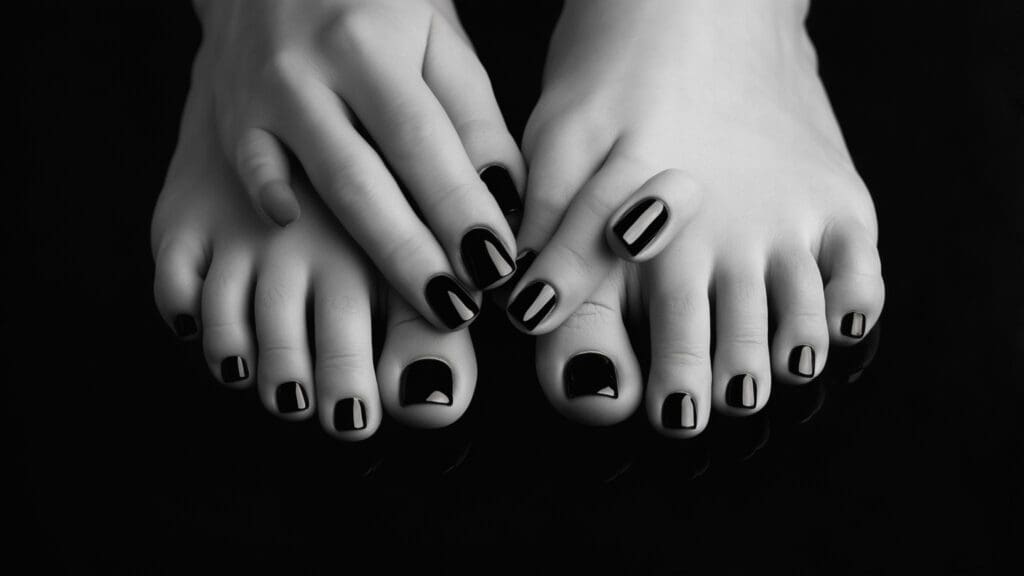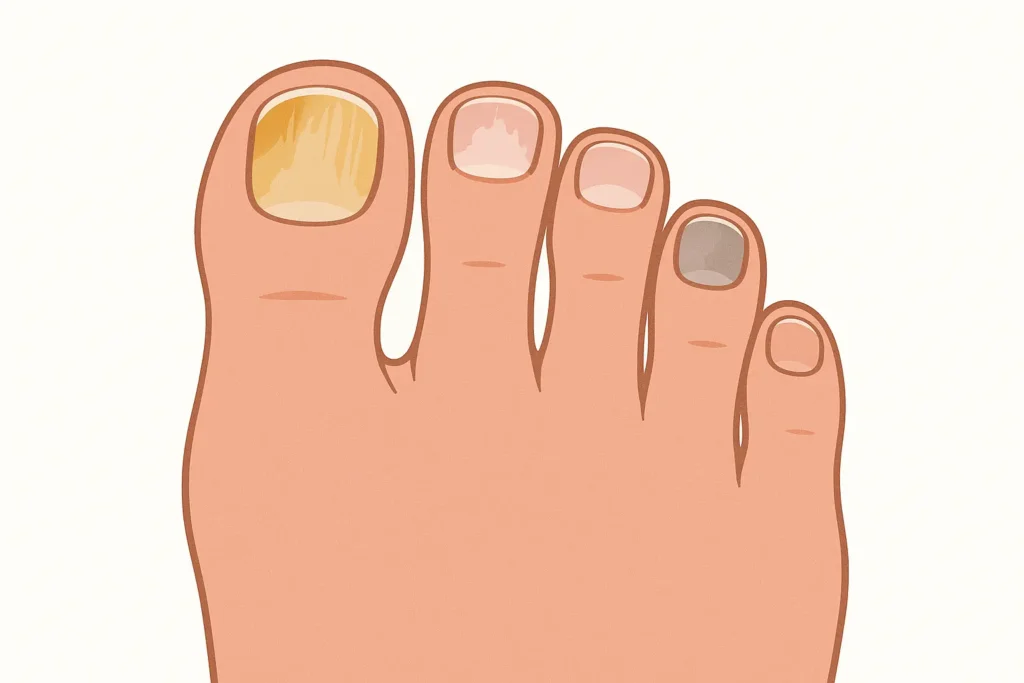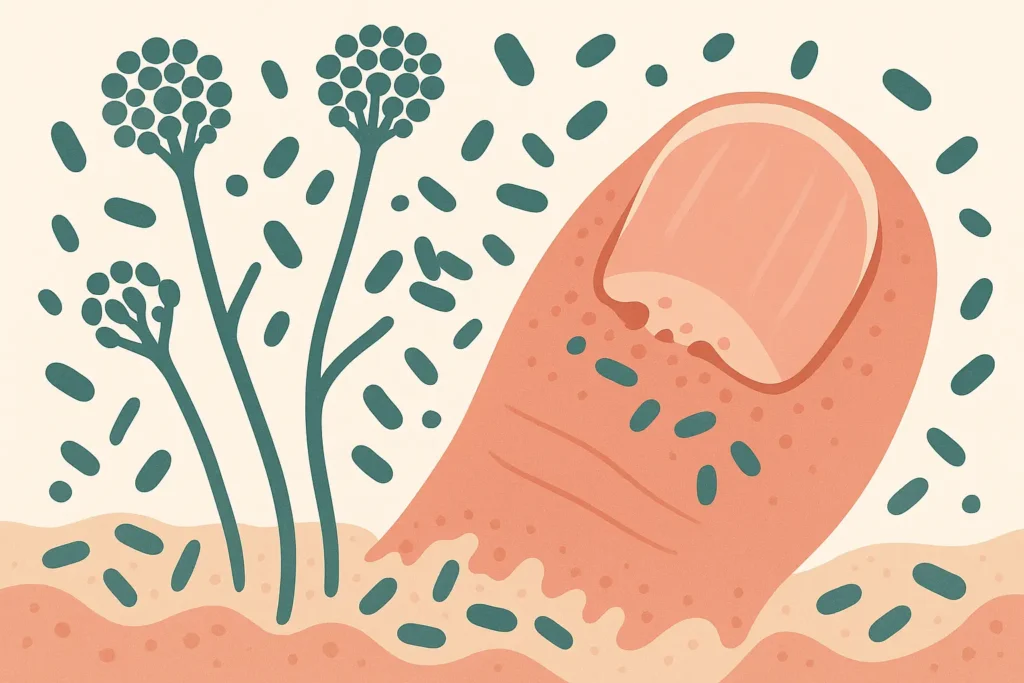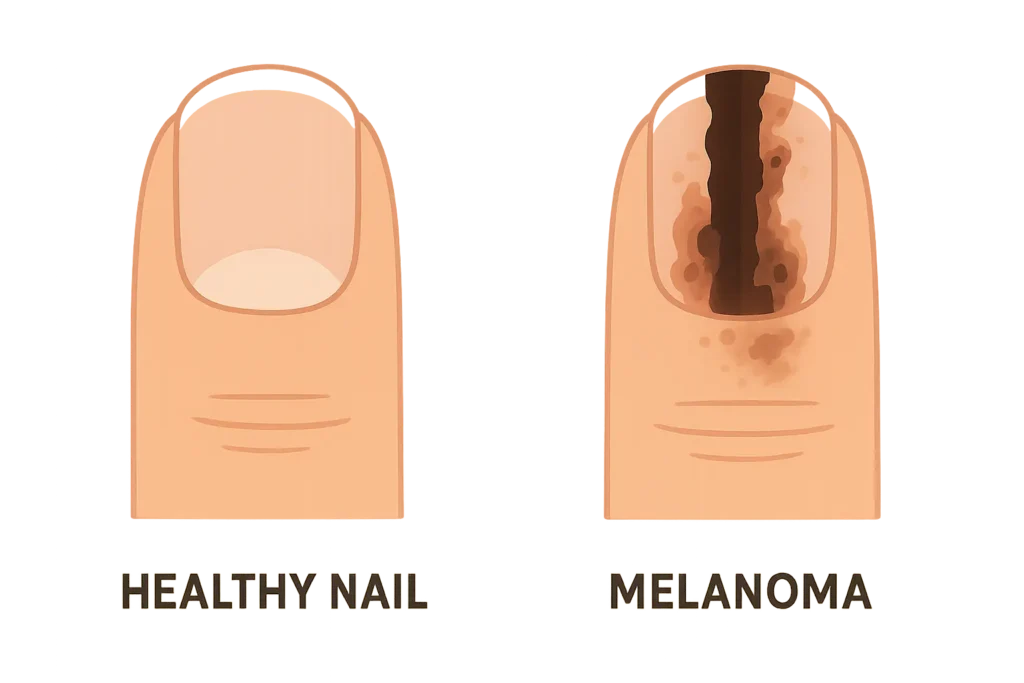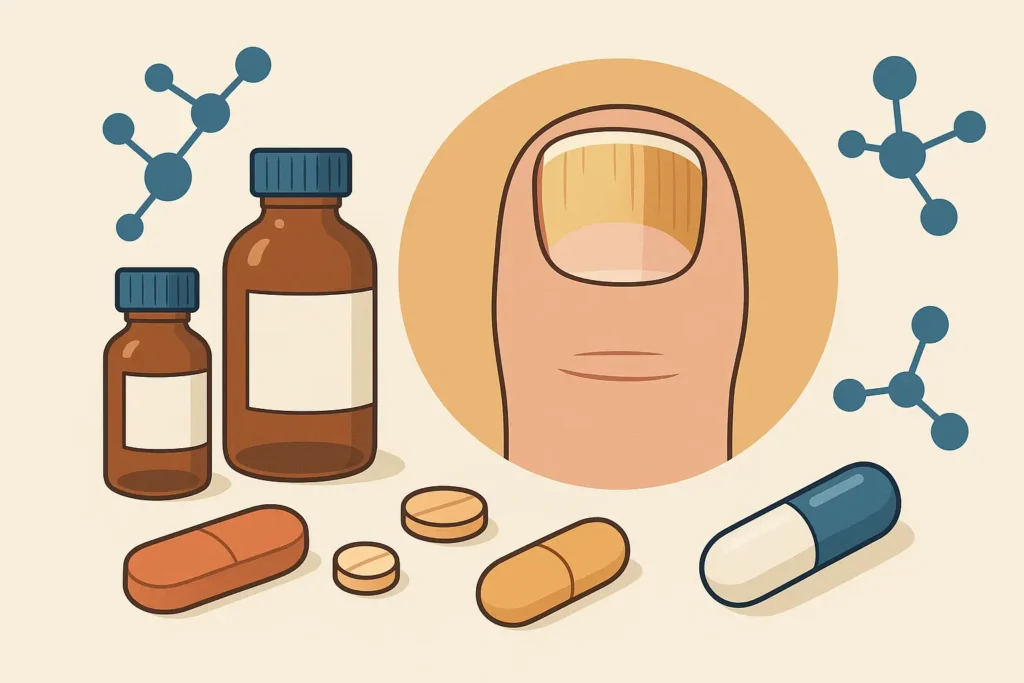I’ll never forget staring down at my big toe after that brutal 10-mile hike, watching a dark shadow slowly spread under my nail. What started as “probably nothing” turned into weeks of worry until I finally worked up the courage to see a doctor. Turns out, I wasn’t alone – black toenails affect about 2-5% of people according to podiatric studies, with good old-fashioned trauma being the culprit in 60% of cases.
Here’s the thing about black toenails: they’re like warning lights on your car dashboard. Sometimes it’s just a loose gas cap (minor trauma that’ll heal on its own), but other times it’s signaling something that needs immediate attention. Understanding what you’re looking at can save you from unnecessary panic or, more importantly, help you catch something serious before it becomes a real problem.
Quick Resources:
-
Plan Your Wedding Stress-Free: AI Wedding Planner
-
Explore All Our Wedding Tools: All Wedding Tools
This guide breaks down 25 different types of black toenails into six main categories, helping you figure out when to worry and when to just keep an eye on things.
TL;DR
- Black toenails come from six main causes: trauma, infections, medical conditions, medications, genetic factors, and environmental exposure
- Trauma-related cases (60% of all black toenails) usually heal on their own but might need quick attention for pain relief
- Infections need proper treatment and can take months to clear up completely
- Some conditions like melanoma require immediate medical attention – catching it early can save your life
- Medication-related changes are typically temporary but may take years to fade
- Genetic conditions need regular check-ups to spot any concerning changes
- Environmental factors highlight the importance of protective gear and smart lifestyle choices
- See a doctor immediately if you notice severe pain, pus, spreading color changes, or rapid changes
Understanding Black Toenail Risk Factors
Before you start googling worst-case scenarios, take a step back and assess what you’re actually dealing with. Think of it like being a detective – you need to gather clues about what caused this, how fast it’s changing, what other symptoms you’re experiencing, how long it’s been going on, your overall health, and whether this warrants a trip to the doctor.
Each of these factors tells part of the story and helps determine whether you’re dealing with something that’ll resolve on its own or needs professional attention.
| Risk Factor Category | Low Risk Indicators | Moderate Risk Indicators | High Risk Indicators |
|---|---|---|---|
| Onset Speed | Gradual over months | Moderate over weeks | Sudden within days |
| Pain Level | None to minimal | Moderate, manageable | Severe, throbbing |
| Associated Symptoms | Discoloration only | Mild swelling, odor | Discharge, red streaking |
| Number of Nails | Single nail affected | 2-3 nails involved | Multiple nails, spreading |
| Overall Health | Generally healthy | Chronic conditions managed | Diabetes, immune compromise |
| Previous History | No prior issues | Occasional nail problems | Recurrent infections |
What’s Actually Causing This?
The root cause of your black toenail is like the foundation of a house – everything else builds on it. A hammer dropped on your toe creates a completely different scenario than a slow-growing fungal infection. Different causes need different treatments, different timelines, and different levels of urgency.
Think about what happened before you noticed the discoloration. Did you stub your toe really hard last week? Have you been wearing those new running shoes that feel a bit tight? Or did this just appear gradually without any obvious trigger? These details matter more than you might think.
Take the stress out of planning your wedding with our AI Wedding Planner — your all-in-one tool for effortless organization.
When you’re dealing with a black toenail, figuring out the “why” behind it helps determine whether you need to see someone today, next week, or just keep monitoring it at home.
How Fast Is This Happening?
Speed tells a story. If your toenail turned black overnight after obvious trauma, you’re in a different ballpark than someone whose nail has been slowly darkening over months. Rapid changes usually mean something acute is happening – trauma, sudden infection, or circulation problems that need attention.
Gradual changes over weeks or months might suggest chronic conditions, ongoing infections, or systemic health issues. These typically allow more time for evaluation but still need attention to prevent complications.
My friend Sarah ignored her gradually darkening toenail for months, thinking it was just from her new running shoes. When it started smelling funky and spreading to other nails, she finally saw a doctor who diagnosed a fungal infection. Six months of antifungal treatment later, she learned that tracking changes early could have saved her a lot of time and hassle.
What Else Is Your Body Telling You?
Your body is pretty good at sending signals about what’s wrong. A painless dark streak that’s been stable for years? That’s one conversation with your doctor. Throbbing pain with pus and a foul smell? That’s a completely different emergency.
Pay attention to pain levels, swelling, any discharge or odor, and whether other nails are getting involved. These accompanying symptoms often provide the clearest clues about what’s happening and how urgently you need treatment.
While managing health concerns is important, if you’re planning a wedding and dealing with foot issues, consider reading our guide on wedding planning stress management to help balance health priorities with your special day preparations.
Stay on top of every detail and manage wedding planning stress easily using our AI Wedding Planner.
How Long Has This Been Going On?
Time changes everything when it comes to treatment options. Fresh injuries respond to immediate interventions that won’t help chronic conditions. Meanwhile, long-standing infections might have developed resistance patterns requiring more aggressive treatment.
If you’re dealing with something that just happened, you have different options than someone who’s been living with this for months. Fresh trauma might benefit from immediate pressure relief, while chronic fungal infections need sustained treatment over many months.
Simplify your wedding checklist and timeline with our smart AI Wedding Planner.
Trauma-Related Black Toenails (Types 1-5)
Let’s start with the most common culprits – trauma-related black toenails. These account for about 60% of all cases and happen when something damages your toe enough to cause bleeding under the nail. Think of it like a bruise, but trapped under your nail where it can’t spread out and fade normally.
Most trauma-related black toenails are more bark than bite. They hurt like crazy initially, look scary, but usually heal on their own as new nail grows out. However, some situations need immediate attention to prevent complications or relieve unbearable pressure.
1. The “Ouch, That Really Hurt” Injury (Acute Impact)
This is the classic dropped-hammer-on-toe scenario. One moment you’re fine, the next you’re hopping around seeing stars while blood pools under your nail. The blood vessels under your nail rupture immediately, creating that dark pooling you’ll see within hours.
The good news? The intense initial pain usually subsides as the pressure stabilizes. The bad news? Your nail might not survive this encounter. New nail growth will eventually push out the damaged portion, but this process takes months.
If the pain becomes unbearable or you suspect you’ve broken something, don’t tough it out. Sometimes doctors can relieve the pressure by making a tiny hole in the nail, which provides almost instant relief.
2. The Sneaky Repeat Offender (Repetitive Microtrauma)
This is “runner’s toe” – that gradual darkening that develops from mile after mile of your toe bumping against your shoe. Each individual impact is minor, but they add up over weeks or months like water drops eventually carving through rock.
You probably won’t notice the problem until that telltale darkening appears. Unlike acute injuries, this type often doesn’t hurt much, but it teaches you an important lesson about proper footwear fit.
The gradual nature means you can often continue your activities while monitoring the situation, but getting properly fitted shoes becomes essential to prevent it from happening again.
3. The Heavy-Duty Damage (Crush Injuries)
Heavy machinery, car doors, falling objects – these don’t give you time to think. The crushing force damages everything: nail, nail bed, and potentially the bone underneath. This is not a “wait and see” situation.
Emergency medical evaluation is non-negotiable because complications can develop rapidly without proper treatment. Recovery often involves specialized wound care and may require nail removal, but proper medical management makes a huge difference in outcomes.
4. The Chemical Nightmare (Chemical Burns)
Industrial chemicals don’t discriminate – they damage whatever they touch. The blackening represents actual tissue death, not just bruising, and the damage continues until the chemical is properly neutralized and removed.
This requires immediate medical intervention because every minute counts. Even with proper treatment, you might face permanent changes in nail appearance or growth patterns, but getting professional care immediately minimizes ongoing damage.
5. The Heat Damage (Thermal Burns)
Hot liquid spills or contact with hot surfaces create immediate tissue damage that continues even after removing the heat source. The black appearance represents burned tissue that may extend deeper than what’s visible on the surface.
Temperature and exposure time determine everything about your recovery. Brief contact with moderately hot surfaces might heal with minimal intervention, while prolonged exposure to extreme heat can cause permanent damage requiring surgical treatment.
Infectious Black Toenails (Types 6-10)
While trauma gets most of the attention, infections are the sneaky troublemakers that often fly under the radar until they’ve established themselves. These require accurate diagnosis and proper treatment, with recovery times varying dramatically based on what type of bug has moved into your nail.
Think of infections like unwanted houseguests – some are relatively easy to evict with the right approach, while others dig in and require serious intervention to remove.
6. The Persistent Squatter (Fungal Infections)
Fungal infections are like that houseguest who overstays their welcome – they move in slowly, make themselves comfortable, and are incredibly hard to get rid of. You’ll notice gradual thickening and darkening over months, often with that distinctive musty smell that’s hard to ignore.
The nail becomes brittle and starts separating from the nail bed as the infection progresses. Common culprits include Trichophyton rubrum and Aspergillus niger, which sound scary but respond to treatment with patience.
Treatment demands serious commitment. Topical antifungals require daily application for up to a year, while oral medications work faster but come with more side effects. Recurrence is frustratingly common without proper prevention strategies, so addressing underlying risk factors becomes crucial.
| Infection Type | What It Looks Like | Main Symptoms | How Long Treatment Takes | Chance It Comes Back |
|---|---|---|---|---|
| Fungal | Gradual darkening, thickening | Musty odor, brittle nail | 6-12 months | High (30-50%) |
| Bacterial | Green-black color, rapid onset | Pain, swelling, discharge | 2-4 weeks | Low with proper care |
| Mixed | Variable colors, complex | Multiple symptoms | 3-6 months | Very high |
| Chronic Nail Fold | Inflammation, secondary darkening | Persistent swelling, tenderness | 2-8 weeks | High without lifestyle changes |
| Biofilm-Related | Treatment-resistant, recurring | Cycles of improvement/worsening | 6+ months | Extremely high |
7. The Loud Troublemaker (Bacterial Infections)
Bacterial infections announce themselves like a smoke alarm – loud, impossible to ignore, and demanding immediate attention. Pain intensifies rapidly, swelling becomes obvious, and you might notice pus or unusual discharge.
Pseudomonas creates that distinctive green-black color that’s unmistakable once you’ve seen it. Other bacteria cause different color patterns, but they all share common features: pain, swelling, and rapid progression without treatment.
Red streaking extending from the toe is your body’s way of waving a red flag – this could signal the infection spreading through your bloodstream, requiring immediate emergency care.
8. The Complicated Situation (Mixed Infections)
Sometimes your toe can’t decide between fungal and bacterial infections, so it hosts both. These mixed infections create confusing symptoms that don’t fit typical patterns – you might see rapid bacterial changes combined with chronic fungal thickening.
Treatment becomes more complex because single medications won’t address both problems effectively. You’ll need combination therapy and careful monitoring, with longer recovery times and higher recurrence rates.
9. The Workplace Hazard (Chronic Nail Fold Inflammation)
Chronic inflammation around nail edges creates the perfect breeding ground for secondary infections. This often relates to occupational moisture exposure or habits like nail biting that create constant irritation.
Success requires addressing both the infection and the underlying habits. Antimicrobial therapy alone won’t prevent recurrence if you continue exposing the area to moisture or trauma through work or lifestyle factors.
Maria, a chef, kept getting nail fold infections despite multiple rounds of antibiotics. The constant handwashing and moisture exposure at work created perfect conditions for bacteria to thrive. Only when she started using waterproof gloves during prep work and implemented strict foot hygiene did the infections finally stop recurring.
10. The Stubborn Survivor (Biofilm-Associated Infections)
Biofilms represent bacterial intelligence at work – these protective barriers allow infections to persist despite aggressive treatment. You’ll experience frustrating cycles of apparent improvement followed by rapid recurrence.
Standard antibiotics can’t penetrate established biofilms effectively, requiring specialized approaches including biofilm-disrupting agents, mechanical removal, or prolonged combination therapy. Professional management becomes essential for successful resolution.
Medical Condition-Related Black Toenails (Types 11-15)
Now we’re getting into the serious territory where your black toenail might be your body’s way of telling you about bigger health issues. These range from life-threatening conditions requiring immediate intervention to chronic diseases that need ongoing management.
The key here is recognizing when your toenail changes might be the tip of the iceberg, signaling something that needs comprehensive medical attention beyond just local nail care.
11. The Silent Killer (Melanoma Under the Nail)
Here’s the scary truth about melanoma under your nail – it doesn’t play by the usual skin cancer rules. No sun damage needed, and it’s incredibly easy to miss until it’s too late. Any dark streak or patch that changes over time demands immediate professional evaluation.
Hutchinson’s sign – when pigmentation extends beyond the nail onto surrounding skin – is your body waving a giant red flag. Don’t wait for your next routine appointment; melanoma progression can be rapid and deadly without early intervention.
Early detection dramatically improves survival rates, making urgent consultation potentially life-saving. This isn’t something to monitor at home or put off until it’s convenient.
12. The Diabetes Complication
Diabetes changes the rules for everything related to foot health. Minor trauma that wouldn’t concern healthy people can lead to serious complications in diabetic patients due to poor circulation and compromised immune function.
That painless black toenail might represent significant tissue damage that you can’t feel due to nerve damage (neuropathy). Poor circulation means healing takes longer, and reduced sensation means problems can develop unnoticed.
Regular professional foot examinations become essential for early detection and prevention of serious complications like infections or ulcerations that could ultimately threaten limb preservation.
13. The Circulation Problem (Poor Blood Flow)
Poor circulation doesn’t just affect your heart – it impacts your toes too. Peripheral artery disease reduces blood flow to your feet, causing tissue death that often starts at nail tips and progresses backward.
Pain patterns provide important clues. Discomfort that worsens at night or improves when you hang your foot over the bed edge suggests circulation problems. This type of black toenail often indicates broader cardiovascular issues requiring comprehensive evaluation.
14. The Immune System Attack (Autoimmune Conditions)
Sometimes your immune system gets confused and attacks your own tissues, including nail structures. Conditions like psoriatic nail disease, lichen planus, and lupus create characteristic nail changes that often accompany other symptoms like joint pain or skin rashes.
Treatment focuses on controlling the underlying autoimmune process rather than just addressing nail symptoms. This might require immunosuppressive medications and coordination between multiple specialists for optimal management.
15. The Blood Problem
Blood disorders affect your entire body, including your toenails. Anemia, clotting problems, and other blood-related conditions can cause characteristic nail changes that provide clues about your overall health.
Multiple nail involvement often suggests systemic rather than local problems. If several toenails show similar changes, especially combined with fatigue, easy bruising, or other symptoms, comprehensive blood work becomes essential.
Medication and Chemical-Related Black Toenails (Types 16-18)
Some medications mess with your nails as an unfortunate side effect. These changes are often temporary but may require months to years for complete resolution. The key is balancing medication benefits with cosmetic concerns while providing supportive care during recovery.
16. The Cancer Treatment Side Effect (Chemotherapy Changes)
Cancer drugs are so focused on attacking fast-growing cancer cells that they accidentally damage your fast-growing nail cells too. Medications like doxorubicin, docetaxel, and paclitaxel can cause nail darkening, thinning, or complete loss by damaging the nail matrix.
Multiple nails often show changes simultaneously, creating patterns of darkening, thinning, or complete nail loss. While distressing, these cosmetic concerns are temporary compared to the life-saving benefits of cancer therapy.
Recovery requires patience and supportive care. Your oncology team understands these side effects and can provide strategies for nail protection during treatment. The changes are usually reversible, though complete recovery may take months to years.
17. The Long-Term Medication Effect (Antimalarial Drugs)
Long-term use of medications like chloroquine and hydroxychloroquine can deposit pigments in various body tissues, including your nails. These changes develop gradually over months or years of treatment, creating characteristic blue-gray or black discoloration patterns.
The pigmentation fades slowly after stopping the medication, sometimes taking years for complete resolution. Since these drugs treat serious conditions like lupus or rheumatoid arthritis, the benefits usually outweigh cosmetic concerns.
18. The Treatment Backfire (Topical Medication Reactions)
Sometimes the treatment becomes the problem. Medications intended to help – like silver sulfadiazine, certain antiseptics, or nail treatments – can cause allergic reactions or direct chemical damage, leading to nail discoloration and surrounding skin changes.
Discontinuing the offending agent usually leads to gradual improvement, though complete resolution may take months. Patch testing can identify specific allergens, helping you avoid similar reactions in the future.
Congenital and Developmental Black Toenails (Types 19-22)
These are the conditions you’re born with or develop early in childhood. Unlike acquired black toenails, these typically require long-term monitoring rather than active treatment, with the main goal being to distinguish stable benign patterns from anything that might need intervention.
19. The Birthmark Under Your Nail (Congenital Spots)
Birthmarks under toenails require different thinking than spots that appear later in life. These congenital lesions have been present since birth or early childhood and typically remain stable throughout life.
Regular dermatologic monitoring becomes essential because even benign birthmarks can undergo malignant transformation. Annual or bi-annual examinations help detect any concerning changes early when treatment is most effective.
20. The Family Trait (Genetic Nail Disorders)
Some nail conditions run in families and often involve multiple body systems. Your nail changes might be part of a broader syndrome affecting bones, kidneys, or blood vessels – conditions like nail-patella syndrome or hereditary hemorrhagic telangiectasia.
Genetic counseling can provide valuable information about inheritance patterns and help family members understand their risks. Management focuses on supportive care and monitoring for associated complications rather than trying to “cure” genetic conditions.
21. The Normal Variation (Ethnic Pigmentation)
Normal pigmentation varies significantly among different ethnic groups. Dark streaks or patches that might concern people with lighter skin tones can represent completely normal anatomy in people of African, Asian, or Hispanic descent.
The key distinguishing feature is stability over time. Normal ethnic pigmentation remains consistent, while problematic conditions typically show changes in size, shape, or color intensity over months or years.
22. The Developmental Issue (Nail Formation Problems)
Some people are born with nail matrix defects that affect how nails form from the very beginning. These structural problems may be associated with other developmental issues affecting fingers, toes, or other body systems.
Specialized care from pediatric dermatologists or nail specialists can help optimize both function and appearance. While complete correction isn’t always possible, many interventions can significantly improve quality of life.
Environmental and Lifestyle-Related Black Toenails (Types 23-25)
Your job, hobbies, and daily activities can all impact your toenail health in ways you might not expect. These conditions emphasize prevention through protective equipment and smart lifestyle choices, with treatment focusing on removing exposure sources and allowing natural healing.
23. The Occupational Hazard
Certain jobs expose you to substances that gradually stain your nails. Coal miners, mechanics, and painters often develop characteristic dark discoloration from repeated contact with coal dust, oils, or pigments affecting multiple nails and surrounding skin.
Prevention beats treatment every time with occupational exposures. Proper gloves, protective equipment, and workplace safety measures can prevent most staining. Once staining occurs, it may take months for new nail growth to replace the discolored portions.
24. The Beauty Product Backfire
Beauty products sometimes cause the problems they’re meant to solve. Nail polishes, henna applications, and temporary tattoos can trigger allergic reactions or cause direct staining that persists long after removal.
Jennifer, a college student, developed severe black discoloration and swelling around her toenails after applying henna for a cultural celebration. The reaction persisted for weeks despite removing the henna, requiring topical steroids and careful product avoidance.
Patch testing can identify specific allergens, helping you choose safer alternatives. Hypoallergenic products reduce reaction risks, though complete avoidance of problematic ingredients remains the most effective prevention strategy.
25. The Activity-Related Wear
Your hobbies and activities can impact your toenail health in unexpected ways. Martial arts, extreme sports, and dance create repetitive stress patterns that gradually damage nails through constant impact or pressure.
Finding the right balance between activity participation and nail health requires creativity. Protective equipment, technique modifications, or activity adjustments can often prevent problems without forcing you to give up activities you love.
When You Need to See a Doctor
Some situations can’t wait for regular appointments, while others benefit from scheduled evaluation within days to weeks. Understanding these distinctions can prevent complications and ensure you get appropriate care at the right time.
| Urgency Level | Timeframe | Warning Signs | What to Do |
|---|---|---|---|
| Emergency | Right now | Severe pain + discharge, red streaking, suspected fracture | Go to ER or urgent care |
| Urgent | Within 24-48 hours | Melanoma features, rapid spreading, diabetes complications | Call doctor immediately |
| Scheduled | Within 1-2 weeks | Gradual changes, chronic infections, medication effects | Schedule appointment |
| Monitoring | Regular check-ups | Stable genetic marks, slow healing trauma | Document changes, routine care |
Drop Everything and Go
Severe pain combined with swelling and discharge suggests serious infection that could spread through your bloodstream without prompt treatment. Red streaking extending from your toe represents potential blood poisoning requiring emergency care.
Suspected melanoma features – irregular borders, color variation, or rapid changes – demand immediate dermatological evaluation. Early detection dramatically improves survival rates, making urgent consultation potentially life-saving.
Call Your Doctor Soon
Not every black toenail requires emergency care, but professional evaluation remains important for proper diagnosis and treatment planning. Gradual changes, chronic infections, or conditions associated with diabetes or circulation problems benefit from scheduled appointments within days to weeks.
Professional evaluation provides peace of mind and ensures you’re not missing serious underlying conditions. Early intervention often prevents complications and improves treatment outcomes significantly.
How Bridesmaid for Hire Supports Your Health Journey
Planning your wedding involves countless details, including ensuring you look and feel your best from head to toe. When you’re dealing with a concerning black toenail just weeks before your big day, the stress can feel overwhelming – you want everything perfect, but health concerns create uncertainty.
Just as professional support helps navigate wedding planning challenges, having someone in your corner during health concerns can make the difference between anxiety and confidence. Whether you’re preparing for your special day or dealing with any life stressor, professional guidance helps you focus on what matters most.
Let our AI Wedding Planner handle the details so you can focus on feeling your best before your big day.
If you’re preparing for your wedding and dealing with foot health concerns, don’t let uncertainty overshadow your special day. Seek appropriate medical care for health issues while knowing that professional support is available for all aspects of your wedding planning journey.
Plan your perfect day with our AI Wedding Planner — designed to make wedding prep simple and stress-free.
Bottom Line
Black toenails run the gamut from simple trauma that heals naturally to serious medical conditions requiring immediate intervention. The key is recognizing warning signs that demand immediate attention – severe pain with discharge, rapid changes, or features suggesting melanoma – while understanding that many black toenails resolve naturally with time and proper care.
Your overall health, what caused the problem, and accompanying symptoms all influence how urgently you need treatment. Prevention strategies vary but often involve proper footwear, protective equipment, good hygiene, and addressing underlying health conditions.
Trust your gut. If something seems off with your toenail and it’s bothering you, get it checked. Most of the time it’s nothing serious, but the peace of mind is worth a quick doctor visit. Your feet carry you through life’s most important moments – treat them with the care and attention they deserve.
Make sure every wedding detail is flawless with help from our AI Wedding Planner.
Whether you’re dealing with a simple black toenail from athletic activities or more complex medical conditions, understanding the various types helps you make informed healthcare decisions. Early intervention typically leads to better outcomes and prevents complications that could affect your long-term foot health and overall well-being.
1-800-BRIDESMAID
The Newlywed
Card Game
something extra to love
Read the weekly newsletter from Bridesmaid for Hire, 1-800-Bridesmaid, to hear about real stories, from strangers, who need advice on love, life, friendship, and so much more.
Looking for the perfect wedding gift for someone you adore? Grab The Newlywed Card Game. It's a fun and interactive game they can play on their honeymoon or future date nights.
